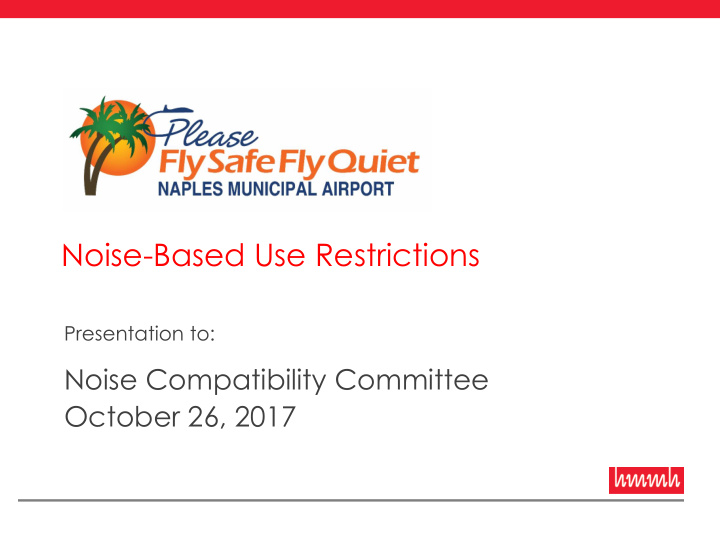



Noise-Based Use Restrictions Presentation to: Noise Compatibility Committee October 26, 2017
Topics Legislative and regulatory background to noise restrictions Grandfathered Use Restrictions Airport initiatives related to new noise restrictions Constraints and Opportunities for Naples
Airport Noise and Capacity Act of 1990, ANCA Required FAA to complete phase-out of Stage 2 aircraft over 75,000 pounds by 12/31/91 • FAA promulgated Part 91 amendment (1991) Required FAA to establish regulations regarding analysis, notice, and approval of airport noise and access restrictions • FAA implemented through FAR Part 161 (1991) Required FAA to develop an national aviation noise policy • Draft “Aviation Noise Abatement Policy 2000” published July 14, 2000, but never finalized Grandfathered existing airport noise and access restrictions
Airport Noise and Capacity Act (ANCA), 1990 ANCA Requirement FAA Implementation Required FAA to complete phase-out of FAA promulgated Part 91 amendment Stage 2 aircraft over 75,000 pounds by (1991) 12/31/91 Required FAA to establish regulations FAA implemented through FAR Part 161 regarding analysis, notice, and approval (1991) of airport noise and access restrictions Required FAA to develop an national Draft “Aviation Noise Abatement Policy aviation noise policy 2000” published July 14, 2000, but never finalized; FAA Flight Plan’ Grandfathered existing airport noise No FAA action required and access restrictions
Part 161: Notice and Approval of Airport Noise and Access Restrictions Establishes federal program for reviewing noise and access restrictions on use of Stage 2 and 3 aircraft • Stage 2 restrictions are moot as of January 1, 2016, when the federal government banned all Stage 2 operations (with very limited case-by-case exceptions) Comprehensive analysis required, e.g.: • Evidence of noise problem Must use DNL • Impact analysis Must consider costs to all parties (operators, passengers, shippers, governments, businesses, airports, etc.) Benefit-cost analysis • “Monetized” noise benefits must exceed costs • Noise shifted to another airport cannot be counted as a benefit Encourages voluntary agreements
Part 161: Notice and Approval of Airport Noise and Access Restrictions Statutory conditions for approval of an access restriction • Reasonable, nonarbitrary, and nondiscriminatory • No undue burden on interstate or foreign commerce • Maintain safe and efficient use of navigable airspace • No conflict with existing Federal law • Adequate opportunity for public comment • No undue burden on national aviation system Many potential roadblocks • No guidance for benefit/cost analysis • Aviation interests - a key data source, unlikely to assist • FAA has made its opposition clear Naples precedent was significant in several ways • FAA grant assurances are “pre - existing law,” which must be addressed in addition to Part 161 • Airports may use local noise standards if they are formally adopted and rigorously enforced (e.g., 60 DNL at Naples)
Use Restrictions “Grandfathered” under Part 161 60 +/- U.S. airports claim to have adopted formal time-of-day, and/or noise-level-based operating restrictions , which can be based on published or measured noise levels 200 +/- U.S. airports claim to have formal noise abatement operating procedures; i.e., noise abatement flight corridors, runway use programs, or departure profiles, etc. Many of these are misleading, as some “restrictions” are actually voluntary, or not well enforced. There are about a dozen airports with actively enforced restrictions.
Grandfathered Restrictions Type of Airport Restriction Details Status Restriction Curfew San Diego (SAN) Night departure curfew with different hours for Stage 3 and non-Stage 3 Non-stage 3 curfew aircraft moot San Jose (SJC) Published-level-based curfew on Stage 3 aircraft; Stage 2 curfew moot Stage 2 curfew Published Noise Van Nuys (VNY) Night noise rule based on published noise levels for Stage 1 or 2 aircraft Moot Level Limits Burbank (BUR) Curfew applies to aircraft that have been “ hushkitted ” to meet Stage 3 Active Baltimore (BWI) Runway use restriction based on published noise levels Active Washington (DCA) Curfew based on published noise level Active Measured New York (JFK) Measured single event Active Noise Levels John Wayne (SNA) Measured single event Active Long Beach (LGB) Measured single event Active Montgomery Field (MYF) Measured single event Active Santa Monica (SMO) Measured single event Active Teterboro (TEB) Measured single event Active
Post-ANCA Airport Initiatives Part 161 initiatives are studies of last resort - perhaps a dozen airports have pursued • Some abandoned, some disapproved by FAA, some resulted in purely voluntary agreements • Since 1991, FAA has approved only two new restrictions Naples Stage 2 ban and Van Nuys Stage 2 phaseout • Two most legitimate “failed” efforts were at Burbank (curfew) and LAX (formal nighttime preferential runway use program) Both multi-million dollar efforts ($7M at BUR, $3M at LAX) resulted in FAA acceptance of the applications as “complete,” but disapproval of the proposed restrictions based on failure to meet statutory conditions All other formal use restrictions currently in place in the U.S. were “grandfathered” under ANCA and Part 161.
Opportunities for Naples • Publicize NBAA Noise Abatement Program, ‘Quiet Flying Is Good Business ’ • Review/publicize recommended noise abatement flight profiles (e.g., NBAA ‘High Density’ NADP) • Work with FAA to raise 2000’ Initial Departure Altitude Restriction • Master Plan Update
Discussion
Recommend
More recommend